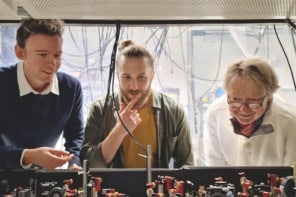Indian physicists have put forward a new way to test for "quantum gravity" -- the field of theoretical physics that attempts to reconcile Einstein's theory of general relativity and quantum mechanics. If successful, the test -- which is based on "loop quantum gravity" -- would be the first ever experimental evidence for quantum gravity. The experiment involves observing a dying star dimming briefly at the end of its life, rather than undergoing a "naked singularity" to create an ultra-dense fireball (Phys. Rev. Lett 96 031302).

Naked singularities are one of the most exotic predictions of Einstein’s theory of relativity. They are ultra-dense fireballs that are thought to form from when a massive dying star more than four to five times heavier than the Sun exhausts its nuclear fuel and collapses under its own weight. The singularities are called naked because they could, in principle, be seen by astronomers.
However, in the final stages of a star’s collapse, the curvature of space-time becomes so large that classical general relativity theory no longer holds and quantum-gravity effects should take over. Indeed, physicists expect that quantum gravity would modify Einstein’s theory near the singularity so that it is not formed at all. Pankaj Joshi and Rituparno Goswami of the Tata Institute of Fundamental Research in Mumbai and Parampreet Singh, now at Penn State University in the US, have now confirmed this hypothesis.
By applying the techniques of loop quantum gravity — a leading candidate for a quantum theory of gravity — Joshi and co-workers calculated that a dying star does not form a naked singularity but has all its mass thrown away in a flash instead. This burst has a characteristic signature: the star dims briefly before it rapidly radiates away to produce extreme energy gamma rays, cosmic rays and neutrinos. If this fingerprint were observed by astronomers, it might provide the first true observational test for quantum gravity.
“Our work shows that the fundamental physics of loop quantum gravity may lead to observable phenomena in astrophysics,” Joshi told PhysicsWeb. “It opens a new frontier to link the theory of quantum gravity with empirical physics and astronomical observations.” The Indian team says that upcoming experiments like the Extreme Universe Space Observatory (EUSO), expected to start running in 2010, could help provide a test for the prediction.
Carlo Rovelli of the Université de la Mediterranée in France thinks the new result might be important. “If it worked, it would be a major step ahead,” he says. “In addition, it is another example in a growing number of suggestions that quantum gravity observations are do-able — contrary to what was believed only a few years ago.”
Giovanni Amelino-Camelia from the University of Rome La Sapienza says that the new proposal is exciting but should be treated carefully. “The picture the authors advocate makes a lot of sense and the results are definitely encouraging. However, it will take time to fully establish the result within the rich formalism of loop quantum gravity.”



